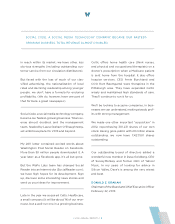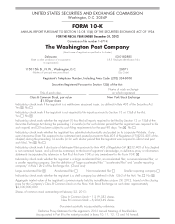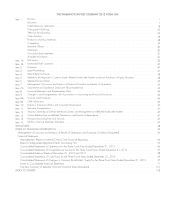Washington Post 2012 Annual Report Download - page 17
Download and view the complete annual report
Please find page 17 of the 2012 Washington Post annual report below. You can navigate through the pages in the report by either clicking on the pages listed below, or by using the keyword search tool below to find specific information within the annual report.Rulemaking Initiatives. On July 1, 2011, DOE regulations went into effect that were designed to address various
program integrity topics. The topics covered in the regulations include, but are not limited to, the following:
• Revisions to the incentive compensation rule (see Incentive Compensation section below);
• Expansion of the notice and approval requirements for adding new academic programs and new reporting and
disclosure requirements for academic programs;
• Revision and expansion of the types of activities that are deemed a “substantial misrepresentation” and the ability of
the DOE to enforce the provisions;
• Requirement that states authorize institutions and set forth certain minimum requirements to obtain such authorizations
(see State Authorization section below);
• Limiting agreements between related institutions;
• Defining a “credit hour”;
• Administration of ability-to-benefit examinations;
• Student attendance requirements;
• Proof of high school graduation;
• Verification of information included on student aid applications;
• Satisfactory academic progress;
• Retaking coursework;
• Return of Title IV funds; and
• Disbursements of Title IV funds.
The implementation of the final regulations has required KHE to change its practices to comply with these requirements,
which has resulted in increased administrative costs and has also increased the risk of incorrect application of U.S.
Federal financial aid.
Gainful Employment. In June 2011, the DOE issued final regulations that tie an education program’s Title IV eligibility
to whether the program leads to gainful employment. On June 30, 2012, the United States District Court for the District of
Columbia overturned most of the final regulations on gainful employment. The DOE is reviewing the details of the Court’s
decision in consultation with the Department of Justice and evaluating their plans, which may include an appeal. As a
result, the ultimate outcome of gainful employment regulations and their impact on Kaplan’s operations is uncertain.
The regulations as originally issued defined an education program that leads to gainful employment as one that complies
with the following gainful employment metrics as calculated under the complex formulas prescribed in the regulations:
(1) the average annual loan payment for program graduates is 12% or less of annual earnings; (2) the average annual
loan payment for program graduates is 30% or less of discretionary income, generally defined as annual earnings above
150% of the U.S. Federal poverty level; and (3) the U.S. Federal loan repayment rate must be at least 35% for loans
owed by students for attendance in the program regardless of whether they graduated.
Under the regulations as proposed, programs would have been subject to various consequences for failure to satisfy
gainful employment metrics. If a program failed all three of the gainful employment metrics in a single U.S. Federal fiscal
year, the DOE would have required the institution, among other things, to disclose to current and prospective students the
amount by which the program underperformed the metrics and the institution’s plan for program improvement and to
establish a three-day waiting period before students can enroll. If a program failed to achieve the metrics twice within
three years, the DOE would have required the institution, among other things, to disclose to current and prospective
students that they should expect to have difficulty repaying their student loans; that the program is at risk of losing eligibility
to receive U.S. Federal financial aid; and that transfer options exist, including providing resources to students to research
other education options and compare program costs. If a program failed three times within a four-year period, the DOE
would have terminated the program’s eligibility for U.S. Federal student aid, and the institution would not have been able
to reestablish the program’s eligibility for at least three years, although the program could have continued to operate
without student aid. The final rule was scheduled to go into effect on July 1, 2012. However, the first final debt measures
would not have been released until 2013, and a program could not have lost eligibility until 2015.
Based on current information, Kaplan does not believe that the regulations as originally issued would have adversely
impacted most of Kaplan’s current programs. However, some of the data needed to compute program eligibility under
this regulation, including graduate incomes, are not readily accessible to the institutions, but are compiled by the DOE. In
addition, the continuing eligibility of programs for Title IV funding may be affected by factors beyond Kaplan’s control,
such as changes in the actual or deemed income level of its graduates, changes in student borrowing levels, increases in
2012 FORM 10-K 5
























